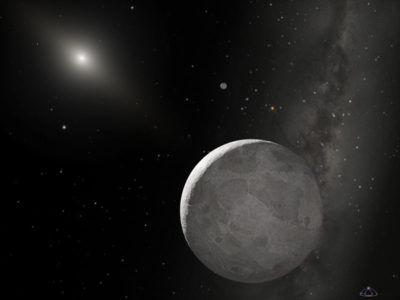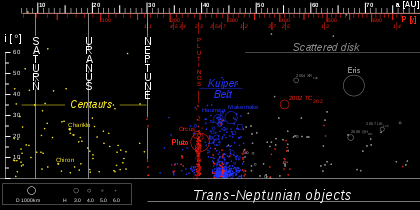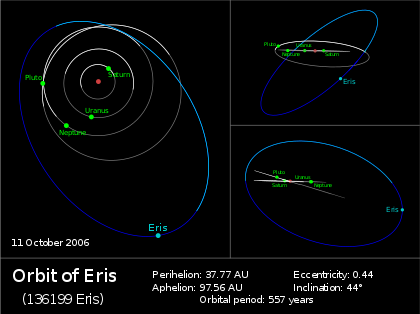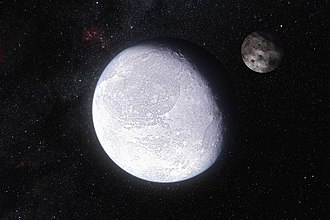
Discovery
Eris was discovered by the team of Mike Brown, Chad Trujillo and David Rabinowitz on January 5, 2005, with the help of images taken on October 21, 2003. The discovery was announced on July 29, 2005.
The search team had been systematically scanning for large outer Solar System bodies for several years and had been involved in the discovery of several other large TNOs, including 50000 Quaoar, 90482 Orcus, and 90377 Sedna.
Routine observations were taken by the team on October 21, 2003, using the 1.2 m Samuel Oschin Schmidt telescope at Palomar Observatory, California However, the image of Eris was not discovered at that point due to its very slow motion across the sky: The team’s automatic image-searching software excluded all objects moving at less than 1.5 arcseconds per hour to reduce the number of false positives returned.
When Sedna was discovered in 2003, it was moving at 1.75 arcsec/h and with that information in hand, the team reanalyzed their old data with a lower limit on the angular motion, sorting through the previously excluded images by eye. In January 2005, the re-analysis revealed Eris’s slow motion against the background stars.
Follow-up observations were then carried out to make a preliminary determination of Eris’s orbit, which allowed the object’s distance to be estimated. The team had planned to delay announcing their discoveries of the bright objects Eris and Makemake until further observations and calculations were complete, but announced them both on July 29 when the discovery of another large TNO they had been tracking, Haumea, was controversially announced on July 27 by a different team in Spain.
More observations released in October 2005 revealed that Eris has a moon, later named Dysnomia. Observations of Dysnomia’s orbit permitted scientists to determine the mass of Eris, which in June 2007 they calculated to be (1.66±0.02)×1022 kg (27%±2% greater than Pluto’s)
Name
Initially, Eris was given a provisional designation, the so-called “license plate” name and then eventually a name based on Greek mythology.
Eris is named after the Greek goddess Eris (Greek Ἔρις), a personification of strife and discord. The name was proposed by the Caltech Team on September 6, 2006 and it was assigned on September 13, 2006, following an unusually long period in which the object was known by the provisional designation 2003 UB313, which was granted automatically by the IAU under their naming protocols for minor planets. The regular adjectival form of Eris is Eridian.
Due to uncertainty over whether the object would be classified as a planet or a minor planet, because different nomenclature procedures apply to these different classes of objects, the decision on what to name the object had to wait until after the August 24, 2006 IAU ruling. As a result, for a time the object became known to the wider public as Xena.
“Xena” was an informal name used internally by the discovery team. It was inspired by the title character of the television series Xena: Warrior Princess. The discovery team had reportedly saved the nickname “Xena” for the first body they discovered that was larger than Pluto.
Choosing an official name
According to science writer Govert Schilling, Brown initially wanted to call the object “Lila“, after a concept in Hindu mythology that described the cosmos as the outcome of a game played by Brahman. Brown was mindful of not making his name public before it had been officially accepted (as he had done so with Sedna a year previously and had been heavily criticized). However, no objection was raised to the Sedna name other than the breach of protocol, and no competing names were suggested for Sedna.
Brown had also speculated that Persephone (wife of the god Pluto) would also be a good name for the object. The name had been used several times in science fiction and was popular with the public. This was not possible once the object was classified as a dwarf planet, because there is already an asteroid with that name (399 Persephone).
With the dispute resolved, the discovery team proposed Eris on September 6, 2006. On September 13, 2006 this name was accepted as the official name by the IAU. Brown decided that, because the object had been considered a planet for so long, it deserved a name from Greek or Roman mythology, like the other planets. The asteroids had taken the vast majority of Graeco-Roman names.
Eris, whom Brown described as his favorite goddess, had fortunately escaped inclusion. The name in part reflects the discord in the astronomical community caused by the debate over the object’s classification.
Planet Classification

Eris is a trans-Neptunian dwarf planet (plutoid). Its orbital characteristics more specifically categorize it as a scattered-disk object (SDO), or a TNO that has been “scattered” from the Kuiper belt into more-distant and unusual orbits following gravitational interactions with Neptune as the Solar System was forming.
Although its high orbital inclination is unusual among the known SDOs, theoretical models suggest that objects that were originally near the inner edge of the Kuiper belt were scattered into orbits with higher inclinations than objects from the outer belt. Inner-belt objects are expected to be generally more massive than outer-belt objects, and so astronomers expect to discover more large objects like Eris in high-inclination orbits, which planetary searches have traditionally neglected.
Because Eris was initially thought to be larger than Pluto, it was described as the “tenth planet” by NASA and in media reports of its discovery. In response to the uncertainty over its status, and because of ongoing debate over whether Pluto should be classified as a planet, the IAU delegated a group of astronomers to develop a sufficiently precise definition of the term planet to decide the issue.
This was announced as the IAU’s Definition of a Planet in the Solar System, adopted on August 24, 2006. At this time, both Eris and Pluto were classified as dwarf planets, a category distinct from the new definition of planet. The IAU subsequently added Eris to its Minor Planet Catalogue, designating it (136199) Eris
Orbit

Eris has an orbital period of 557 years. Its maximum possible distance from the Sun (aphelion) is 97.65 AU, and its closest (perihelion) is 37.91 AU. When discovered Eris and its moon were the most distant known objects in the Solar System, apart from long-period comets and space probes. It retained this distinction until the discovery of 2018 VG18 in 2018.
Eris’s orbit is highly eccentric and brings Eris to within 37.9 AU of the Sun, (a typical perihelion for scattered objects). This is within the orbit of Pluto, but still safe from direct interaction with Neptune (29.8–30.4 AU).
Unlike the eight planets, whose orbits all lie roughly in the same plane as the Earth’s, Eris’s orbit is highly inclined: It is tilted at an angle of about 44 degrees to the ecliptic. In about 800 years, Eris will be closer to the Sun than Pluto for some time.
As of February 2016, Eris has an apparent magnitude of 18.7, making it bright enough to be detectable to some amateur telescopes. A 200-millimeter (7.9 in) telescope with a CCD can detect Eris under favorable conditions. The reason it had not been noticed until now is its steep orbital inclination; searches for large outer Solar System objects tend to concentrate on the ecliptic plane, where most bodies are found.
Because of the high inclination of its orbit, Eris passes through only a few constellations of the traditional Zodiac (it is now in the constellation Cetus). It was in Sculptor from 1876 until 1929 and Phoenix from roughly 1840 until 1875. In 2036 it will enter Pisces and stay there until 2065, when it will enter Aries. It will then move into the northern sky, entering Perseus in 2128 and Camelopardalis (where it will reach its northernmost declination) in 2173.
Size
In November 2010, Eris was the subject of one of the most distant stellar occultations yet from Earth. Preliminary data from this event cast doubt on previous size estimates. The teams announced their final results from the occultation in October 2011, with an estimated diameter of 2326±12 km.
This makes Eris a little smaller than Pluto by area and diameter, which is 2372±4 km across, although Eris is more massive. It also indicates an albedo of 0.96, higher than that of any other large body in the Solar System (except Enceladus).
The mass of Eris can be calculated with much greater precision. Based on the currently accepted value for Dysnomia’s period (15.774 days), Eris is 27 percent more massive than Pluto. Using the 2011 occultation results, Eris has a density of 2.52±0.07 g/cm3, substantially denser than Pluto, and thus must be composed largely of rocky materials.
Models of internal heating via radioactive decay suggest that Eris could have an internal ocean of liquid water at the mantle–core boundary.
In July 2015, after nearly ten years of Eris being considered the ninth-largest object known to directly orbit the sun, close-up imagery from the New Horizons mission more accurately determined Pluto‘s volume to be slightly larger than Eris’s, rather than slightly smaller as previously thought.
Eris is now the tenth-largest object known to directly orbit the sun by volume, but remains the ninth-largest by mass.
Surface and atmosphere
The discovery team followed up their initial identification of Eris with spectroscopic observations made at the 8 m Gemini North Telescope in Hawaii on January 25, 2005. Infrared light from the object revealed the presence of methane ice, indicating that the surface may be similar to that of Pluto and of Neptune’s moon Triton.
Due to Eris’s distant eccentric orbit, its surface temperature is estimated to vary between about 30 and 56 K (−243.2 and −217.2 °C).
Unlike the somewhat reddish Pluto and Triton, Eris appears almost white. Pluto’s reddish color is thought to be due to deposits of tholins on its surface, and where these deposits darken the surface, the lower albedo leads to higher temperatures and the evaporation of methane deposits.
In contrast, Eris is far enough from the Sun that methane can condense onto its surface even where the albedo is low. The condensation of methane uniformly over the surface reduces any albedo contrasts and would cover up any deposits of red tholins.
Even though Eris can be up to three times farther from the Sun than Pluto, it approaches close enough that some of the ices on the surface might warm enough to sublime. Because methane is highly volatile, its presence shows either that Eris has always resided in the distant reaches of the Solar System, where it is cold enough for methane ice to persist, or that the celestial body has an internal source of methane to replenish gas that escapes from its atmosphere.
Satellite

In 2005, the adaptive optics team at the Keck telescopes in Hawaii carried out observations of the four brightest TNOs (Pluto, Makemake, Haumea, and Eris), using the newly commissioned laser guide star adaptive optics system.
Images taken on September 10 revealed a moon in orbit around Eris. In keeping with the “Xena” nickname already in use for Eris, Brown’s team nicknamed the moon “Gabrielle“, after the television warrior princess’ sidekick. When Eris received its official name from the IAU, the moon received the name Dysnomia, after the Greek goddess of lawlessness who was Eris’s daughter.


